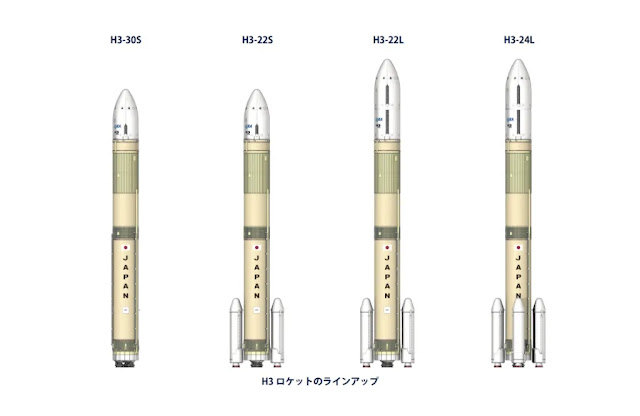JAXA - Japan Aerospace Exploration Agency logo.
Feb 17, 2023
Japan’s space agency JAXA aborted the long-awaited first launch of H3 rocket Feb. 16, when the rocket’s side boosters failed to ignite after main engine start.
Image above: H3 rocket stands on the launch pad at Tanegashima Space Center, Feb. 16, in this image taken from YouTube. Image Credit: JAXA.
It was the latest in a series of setbacks for Japan’s years-long efforts to develop a more capable and cost-effective alternative to the nation’s current workhorse, H-2A.
Live footage showed the 63-meter expendable rocket, decorated with Japan’s national flag on the core stage with two strap-on side boosters attached, standing idle at the seafront launch pad of Tanegashima Space Center when the countdown was over.
Aborted launch of the H3 Launch Vehicle (H3TF1)
“The main engine was ignited, but side boosters were not,” said the range control center, shortly after the rocket’s pre-announced launch window of 8:37-8:44 p.m. Eastern. “It is expected that it would probably take longer to examine the situation. The status of launch vehicle Test Flight No.1 will be announced to all launch operators as soon as it will be confirmed.”
JAXA also left a short notice on its website: “Further information will be updated on the JAXA website.” The agency didn’t elaborate on what happened. It’s also not known yet how the agency will examine the issue — after rolling back the rocket to the hangar or at the launch pad.
The planned launch was initially targeted for Feb. 14, but bad weather caused a two-day delay.
Aboard the rocket was Advanced Land Observing Satellite-3 (ALOS-3), a 3-ton optical imaging satellite, built by Mitsubishi Electric Corporation, which will follow in the footsteps of the original Advanced Land Observation Satellite (ALOS). ALOS was launched in 2006 onboard an H2A and declared dead in orbit in April 2011. ALOS-2 is still operating after being launched in May 2014.
Japan’s journey to develop H3 was long and winding. JAXA began developing H3 in partnership with Mitsubishi Heavy Industries (MHI) in 2014. It is meant to replace H-2A that has been operational since August 2001 with a new one with “high flexibility, high reliability, and high cost-performance.”
The rocket’s inaugural launch was originally scheduled for March 2021, but was pushed back by around two years due to issues with the newly developed LE-9 first-stage engine.
The problems were first uncovered during qualifications testing in May 2020, which included cracked turbine blades in the LE-9’s turbopump assembly and a hole seared into its combustion chamber wall. To fix these, JAXA and MHI had to redesign the engine’s fuel turbopump and apply those same changes to the engine’s oxygen turbopump.
H3’s four variants
There are four variants of the H3 rocket, each in a unique configuration of LE-9 engines and side-mounted solid rocket boosters. The rocket can fly with zero, two, or four strap-on boosters and either two or three LE-9 first-stage engines in order to carry a wider range of payloads to a wider range of orbits. Depending on the version of the rocket, it can place a payload of at least 4 tons into a sun synchronous orbit (SSO), with a maximum capacity of 6.5 tons into a geostationary transfer orbit (GTO). It’s a significant improvement from H-2A’s capacity of 3.8 tons to SSO and 4 tons to GTO. Future upgrades could make it possible for the rocket to deliver cargo to the moon, including the planned lunar Gateway that NASA is pursuing in cooperation with JAXA, the European Space Agency and others.
Image above: Japan’s new H3 rocket is designed to fly with zero, two, or four strap-on boosters and either two or three LE-9 first-stage engines in order to carry a wider range of payloads to a wider range of orbits. Image Credit: JAXA.
The H3 rocket’s LE-9 is not only a more powerful engine than H-2A’s LE-7. It also employs a novel design, called an expander bleed cycle, that Mitsubishi was the first to introduce with its LE-5A upper stage engine. In addition, the H3 stands to be the first rocket to use an expander bleed cycle engine for its first stage, a design choice meant to yield higher engine thrust at the expense of efficiency.
On the price front, the launch cost of the H3 is reportedly around $50 million, half that of the H-2A.
Meanwhile, Japan has launched one orbital mission so far this year: a H-2A successfully delivered Japan’s IGS Radar 7 surveillance satellite to orbit on Jan. 25.
Related links:
Japan Aerospace Exploration Agency (JAXA): https://global.jaxa.jp/
Mitsubishi Heavy Industries (MHI): https://www.mhi.com/
Images (mentioned), Video, Text, Credits:JAXA/Mitsubishi Heavy Industries/SpaceNews/Park Si-soo/SciNews.
Best regards, Orbiter.ch



